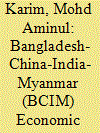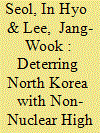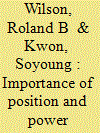|
|
|
Sort Order |
|
|
|
Items / Page
|
|
|
|
|
|
|
| Srl | Item |
| 1 |
ID:
160353


|
|
|
|
|
| Summary/Abstract |
The Belt and Road Initiative (BRI), ostensibly a connectivity and developmental
program, was launched by the Chinese President Xi Jinping with the primary
objective of connecting the common people in Asia through trade, infrastructure
and culture. The initiative is designed to enhance connectivity in areas such as trade,
infrastructure, investment, capital and people. That said, since its inception, the
project seems to confront certain hurdles such as regional geopolitical complexities
and launching of other alternative proposals that tend to hamper its progress. As
part of the BRI, the BCIM–EC proposes to connect eastern China with South Asia
that will also ultimately connect Southeast Asia through different modes for better
economic and cultural connectivity. This paper attempts to evaluate the challenges
and opportunities of the BCIM–EC project in the context of South and Southeast
Asian nations. The paper concludes that the challenges are rather overriding.
|
|
|
|
|
|
|
|
|
|
|
|
|
|
|
|
| 2 |
ID:
160348


|
|
|
|
|
| Summary/Abstract |
The Republic of Korea (ROK) Ministry of National Defense (MND) should
support and guarantee the process of peaceful and diplomatic denuclearization
by providing a perfect deterrence posture that can cope with any contingencies,
while being especially cautious so as not to ignite political tensions. For that
purpose, strengthening the ROK’s own deterrence capability against the North
Korean military threat is becoming more and more important. This is especially
true because the North Korean ICBM capability, which is assessed to be completed
in a short time, is believed to be able to pose the so-called “decoupling situation”
on the Peninsula, by an increasing number of people. Although it is not certain
the decoupling may really happen even if the North does finally achieve ICBM
capability, this is a problem that cannot be ignored, since more and more people are
worrying about it. Several non-nuclear high-tech weapon systems and masterful
tactics to apply them in the Korean situation raise the possibility of dramatically
strengthening the overall deterrence posture against North Korean threat without
any additional nuclear measures. From now on, the ROK MND should formulate
a new version of the ROK’s own deterrence strategy against the North, the “3K+”
which tries to utilize the new possibilities provided by several conventional hightech
weapons, together with the pre-existing 3K systems (Kill Chain, KAMD, and
KMPR). The new strategy should be built more systematically to overwhelm any
possible North Korean military ambitions in advance, defeating any and all military
capabilities that the North is expected to strive for in the future. As Sun Tzu taught,
the highest strategy can frustrate the enemy into surrendering, even without a fight.
|
|
|
|
|
|
|
|
|
|
|
|
|
|
|
|
| 3 |
ID:
160349


|
|
|
|
|
| Summary/Abstract |
This paper analyzes how U.S. foreign policy, based on symmetry or asymmetry,
drives international relations, and can lead to positive or negative state-to-state
relations. The paper uses the case of U.S. foreign policy towards North Korea to
discuss the importance of position and power when dealing with societies and
nations. The paper discloses that U.S. foreign policy approach towards North Korea
has not significantly evolved over the past 60 years regardless of administration
and that the current paradigm of dealing with complex state-to-state issues only
works to sustain negative relations. The paper further finds that the continued
negative relations and deep-rooted and protracted conflict between the United States
and North Korea is intimately connected to the way in which the United States
handles state-to-state relationships. On the basis of these observations, the paper
recommends alternative multi-dimensional foreign policy approaches based on
conflict analysis and resolution methods and tools needed to successfully transform
the relationship and build sustainable peace with North Korea and in the East Asia
Region.
|
|
|
|
|
|
|
|
|
|
|
|
|
|
|
|
| 4 |
ID:
160347


|
|
|
|
|
| Summary/Abstract |
Recently, the international audience is interested in finding cases of denuclearization
in the past to draw out lessons that can be applied to North Korea. In order to
find the optimal reference point, it is crucial to carefully examine the background
of North Korea’s decision to begin denuclearization talks. Thus, this paper will
begin by discussing the overall context of the talks and highlight core issues that
may occur during the process of denuclearization. Next, it will examine which
case is most relevant to the negotiations with North Korea, and will analyze key
implications of Iran’s nuclear deal, which is the most recent and similar to the case
of North Korea. And by focusing on the core issues identified, it will suggest policy
considerations for preparing strategies to continue negotiations with North Korea.
|
|
|
|
|
|
|
|
|
|
|
|
|
|
|
|
| 5 |
ID:
160352


|
|
|
|
|
| Summary/Abstract |
This article aims to assess the progress of the ROK–Japan security cooperation
in recent years, both in the bilateral and trilateral framework involving the United
States. It argues that the unprecedented progress in North Korea’s nuclear program,
along with a constant U.S. persuasion, led to a certain political convergence to allow
and accompany the security cooperation. This said, political mistrust, asymmetric
expectations and diverging perspectives still persist, explaining why the cooperation
is mainly taking place within the trilateral framework. Nevertheless, the latest set
of dialogue, exchanges and joint exercises did build up confidence and highlighted
the benefit of an expanded cooperation while pushing the two countries to seriously
consider the concrete issues, conditions and implications of such cooperation. The
paper concludes that the recent progress in the security cooperation is still fragile
and dependent on external factors, even if it is pointing to a greater understanding.
|
|
|
|
|
|
|
|
|
|
|
|
|
|
|
|
| 6 |
ID:
160346


|
|
|
|
|
| Summary/Abstract |
A successful North Korea–U.S. summit is expected to make a breakthrough in the
denuclearization of the North. Nevertheless, considering the lessons learned from
past denuclearization negotiations, and Pyongyang’s nuclear capacity and will
for nuclear development, a solely optimistic outlook is not advisable. In order to
pursue successful denuclearization negotiations, a precise understanding of new
negotiation conditions, particularly each party’s negotiation strategy and leverage,
and application of them is very important. Also, a substantive negotiation strategy
and roadmap for the denuclearization should be prepared to be able to pressure and
reach an agreement with North Korea. Taking account of the negotiation leverage
of North Korea and the United States, a one-sided negotiation with North Korea
surrendering to the United States is not likely. This paper aims to provide a practical
negotiation strategy and a roadmap for the denuclearization of North Korea
reflecting the current security situation surrounding the Korean Peninsula.
|
|
|
|
|
|
|
|
|
|
|
|
|
|
|
|
| 7 |
ID:
160351


|
|
|
|
|
| Summary/Abstract |
The ROK–China conflicts due to the THAAD deployment in South Korea and
the Trump administration’s preemptive strike doctrine toward the DPRK have put
the security of the Korean Peninsula in a grave state. At the same time, positive
expectations for ROK–DPRK–U.S. talks have been growing recently. However,
since whether the United States will conduct a preemptive strike or not depends
on the results of the U.S.–DPRK talks, the security of the Korean Peninsula is in a
precarious state.
This paper, therefore, attempts to analyze the Sino–North Korean Mutual Aid
and Cooperation Friendship Treaty (hereafter referred to as the Sino–North
Korean Friendship Treaty) that will allow for the reconsideration of China’s role
in nullifying the uncertainty on the Korean Peninsula according to the treaty. The
Automatic intervention, according to Article 2 of the Sino–North Korean Friendship
Treaty, is an exercise of the right of self-defense that can be implemented when the
requirements of necessity and proportionality of Customary International Law are
met, and only until the UN Security council takes appropriate measures, according
to Article 51 of the UN Charter. China’s intervention in the case of contingency on
the Korean Peninsula, according to the Sino–North Korean Friendship Treaty, has
limitations with regards to compliance with Articles 48 and 103 of the UN Charter.
It is a special treaty based on the historical background between North Korea and
China. Also, since China recently adopted “non-alignment” as a foreign policy, it
is unlikely that the
|
|
|
|
|
|
|
|
|
|
|
|
|
|
|
|
| 8 |
ID:
160350


|
|
|
|
|
| Summary/Abstract |
This paper seeks to find an answer to the question of why China’s effort to curb
North Korea’s nuclear development has failed to produce expected outcomes.
Since the second North Korean nuclear crisis in 2002, China, as the most, if not
sole, influential country to North Korea, has been attempting to restrain the North’s
nuclear armament. Nevertheless, Beijing has always failed to sustain its pressure
on Pyongyang long enough to restrain Pyongyang’s nuclear ambition; instead, it
has often ended up with China’s appeasement policy. Witnessing such failure, some
scholars assert that Beijing is able, but not willing, to curb Pyongyang’s nuclear
armament, while others claim that Beijing’s leverage over Pyongyang is a lot
more limited than widely thought. Yet, both schools of thought, focusing narrowly
on China’s capability or willingness to restrain North Korea, has failed to depict
a full picture. By contrast, this study, employing a game theory approach, views
Sino–DPRK relations as a strategic interaction between restrainer and restrainee.
It argues that North Korea’s tactical deception and military adventurism shuffle
China’s political priorities on the Korean peninsula, thereby preventing China from
pressuring North Korea.
|
|
|
|
|
|
|
|
|
|
|
|
|
|
|
|
|
|
|
|
|